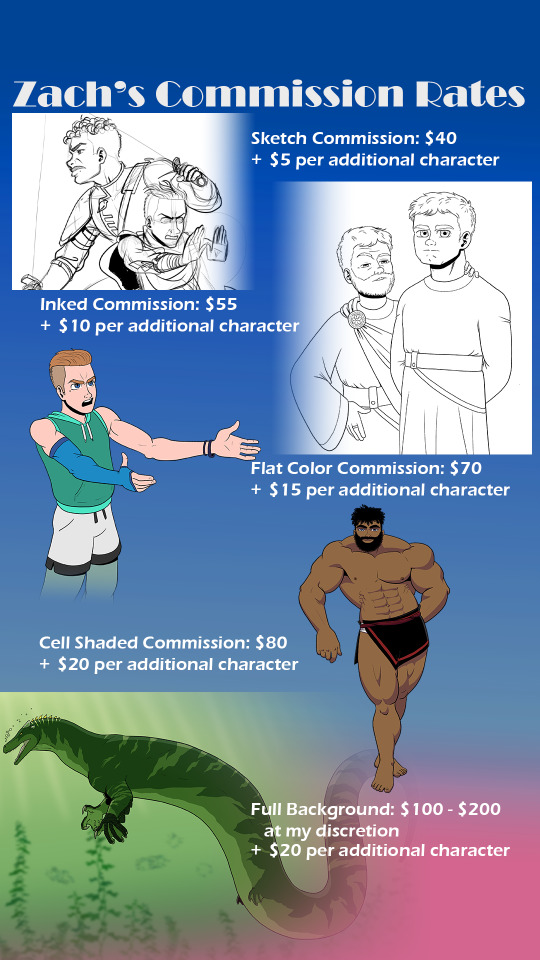Text

It's my 10 year anniversary on Tumblr 🥳
I suddenly feel the weight of eons upon me.
10 notes
·
View notes
Text

Classicstober Day 21: Psyche (𐀟𐀱𐀐)
The story of Eros, the personification of generation and desire, falling in love with the purely mortal human, Psyche, is one of my favorite stories in mythology. Short, sweet, it doesn't even have the typical values dissonance of most ancient Greek myths.
Love them.
As far as I can tell, Psyche never has a canonical place of origin so I decided to go a little indulgent and make her Libu. I had already done some research on the Libu for some thoughts I had about Lamia, who was from Libya according to the mythology and in the late bronze age the Libu were the ones living in Libya (and also have their name to the place). Her clothing, while a little ahistorical in color, is based on Ancient Egyptian depictions of the Libu but a little simplified. The murals show the Libu wearing intricately patterned robes, and despite my best attempts to get that to translate to my style it just did not. The murals also depicted the Libu having intricate and beautiful geometric tattoos, very similar in appearance to the modern Amazigh tattoos. Hers are based on the ancient murals, but with a little Amazigh detailing thrown in. The butterfly wings are a common motif in depictions of her after her apotheosis.
Again, I usually hesitate to depict the divine because they are kind of undepictable, but the thought I had for Eros here is that his love for Psyche makes him look more human (you can see his body becomes flesh-toned where it touches hers). In the mythology there are two distinct origins for Eros. Option A is that he is the Primordial of Procreation, one of the first entities to exist in the Cosmos directly after Chaos. Option B is that he is the son of Aphrodite and Ares. I like to think that he was born as a primordial, but Aphrodite (and Ares to an extent) took him under her proverbial wings to teach him how human love works. The idea of him being profoundly old is why his body is cosmic, a nebula full of stars now molded into a human shape.
59 notes
·
View notes
Text

Classicstober Day 20: Odysseus (𐀃𐀉𐀮𐀄)
Odysseus is one of the most recognizable heroes of Greek mythology, maybe the most recognizable after Heracles/Hercules and various euphemisms (eg Achilles Heel and such). I borrowed Jorge Herran's hairdo for my interpretation of him because Epic has been on my mind and I deeply enjoy his interpretation of the character.
More than any other hero, Odysseus' relationship with his divine patron, Athena, is very close. Some interpretations might even argue too close, and maybe even dangerous…
What can a man say about Odysseus that hasn't already been said before? He is one of those mythological characters that is inescapable if you are dealing with ANY media that handles classical mythology. Polymetis seems to describe both him and his modern interpretations. I can't deny that I have a significant amount of Double Think about this man. To the ancient Greeks he would have been a perfect hero, but today… not so much. He murders without consequence, even if pragmatically, is filled with pride, and while his wife remains the model of chaste patience Odysseus is banging his way around the Mediterranean.
That said, it is very easy to make more palatable modern interpretations of him. He's almost as easy to sanitize as Perseus.
My depiction of him here is probably toward the end of his wanderings, maybe even right before unleashing his bow on the suitors. Since he is supposed to be dressed in beggar's rags his costume took very little research; it's just layers of cloth used as a cloak worn over a tunic. The only little addition I made is an ivory pin in the shape of an owl's face to show Athena's favor.
Athena, on the other hand, was a bit more challenging in pose and costume. I have mentioned before I try to abstain from direct depictions of the gods, but in this piece I wanted her influence on Odysseus to be palpable. The hardest part was making her armor as a war-god. Bronze age panoplies have been discovered and they seem to have been the pinnacle of protection, but I personally loathe the look of them so I decided to go with some Mycenaean vase-painting inspired armor. Although I usually think Athena's theme color would be green to reference her connection to olives, with this one I wanted her to be blindingly gray and white and terrifying.
It is a relatively modern concept to really depict the gods as evil, especially between Athena and Odysseus, but I kind of wanted to suggest that with her pose but still leave it ambiguous. Is the hand on his neck a tender caress, or a promise of a choke? Is she guiding his aim with a gentle touch, or is she forcing him to knock the bow and unleash the bloodshed?
158 notes
·
View notes
Text
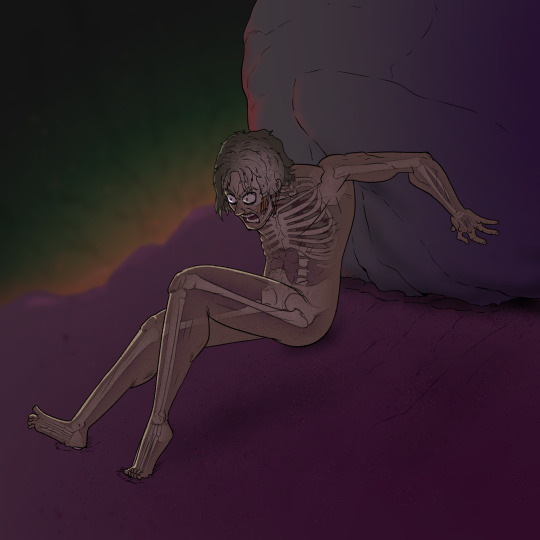
Day 19 of Classicstober: Sisyphus (𐀯𐀱𐀡)
The OG (Original Guest-Killer), Sisyphus managed to run afoul of Zeus, Thanatos, Hades, Ares, Hermes, AND Persephone, which has to be a record, by not only being a serial killer but also scamming the death gods twice. That's why he's stuck with the rock in the underworld. Get rekt.
Look, I know they made him pleasant and sweet in Hades, but Sisyphus was a nasty piece of work. Like I said before, he was an actual serial killer who murdered his guests and then used his status as the King to escape the consequences. It got so bad that the gods decided to cut out the middle man (usually a giant monster or a hero on a quest) and send Thanatos to deal with Sisyphus himself. What followed was something more akin shenanigans set to the Benny Hill Theme than gods vs man, but I love it.
Another very research free piece, I decided that souls in the Underworld would not need clothes since they are already laid bare before Hades and his court. I also added the bones and partial transparency to really hammer home the alien feeling of the Underworld.
Pretty Halloween-y if you ask me.
54 notes
·
View notes
Text
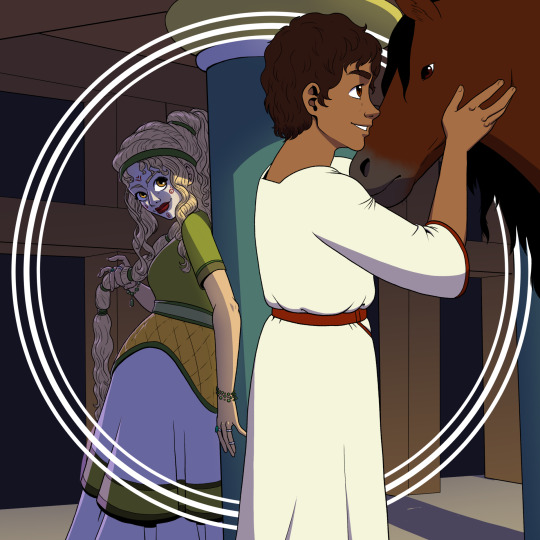
Day 18 of Classicstober: Phaedra (𐀙𐀂𐀉𐀨)
Phaedra was Ariadne's sister and married Theseus to become Queen of Athens (that must have been a WILD Christmas dinner). Things were good until Theseus' son by the Amazon queen dropped by for a visit. His name was Hippolytus (𐀂𐀢𐀬𐀵)…
Phaedra's story isn't quite as well known as many others in greek mythology, outside of a few tragedies and operas. The nature of the beast for most of these stories is that there are a couple of versions and no one can say which one is the 'real' one, but Phaedra's story, depending on the version you go by, can have wildly different vibes.
As I mentioned, she was Ariadne's sister. In some versions, when Ariadne helped Theseus defeat the Minotaur and escape, Phaedra was with her and part of Theseus' crew when he decided to abandon Ariadne on Naxos, eventually becoming his wife in Athens. In others, Phaedra is ignorant of the role Ariadne played in Theseus' victory and is instead sent to Athens to marry him for a political alliance. The implications of both versions are fascinating from a story-telling perspective. If Phaedra left with Theseus, just how complicit was she in leaving Ariadne behind? If their marriage was purely political, what did she think of the man who had just abandoned her sister? In the end, though, the important part (story wise) is that she marries Theseus and becomes Queen of Athens.
I depicted Phaedra here in her full queenly raiment. Yes, Athens was a purely Mycenaean settlement at this time, but the Mycenaean woman's fashion borrowed LOTS from the Minoan and considering where Phaedra was born she deserved a more Minoan look. That's why she has that quilted-looking over-garment on her dress. I made her palette green to represent her role as queen of Athens, and since Athena is the goddess of olive trees it made sense to me to lean into it. She is also blonde and amber-eyed to show her connection to Helios through her mother, Pasiphaë.
The architecture here is based on Minoan buildings. I imagine that inside the Cyclopean walls of Mycenaean Athens they could afford to make things more royal and less military-pragmatism. Athens is known for being a center of intellectualism in the ancient world (an image they painted themselves with), but even though this scene is set many centuries before the height of Classical Athens' power I decided to lean into that here too.
As for Hippolytus… the sources we have for the ancient Amazons are vanishingly rare. Most scholarship has focused on the Phrygians during the Classical Period, and I was able to find precious little reference for the Bronze Age Phrygians that might represent the historical Amazons. I did find one reconstructed garment, and even though it was very plain (and probably mean for a woman) I decided to put Hippolytus in it anyway. The Amazons were practical warriors, so I doubt that, as a child, Hippolytus would have had any other clothes than what his mother had. I also decided that he should be tall, taller than Theseus, as the Amazons were said to stand taller than normal men.
I could go into more details on the very disastrous story between Hippolytus, Phaedra, and Theseus, but I think it falls outside the purview of this piece. It is a fascinating, compelling story, though, so if you have made it this far into my ramble then I recommend checking it out.
156 notes
·
View notes
Text

Day 17 of Classicstober: Atalanta (𐀀𐀲𐀨𐀙)
One of the few women in Greek mythology who is known for her own sake. She was an athlete without peer, raised by bears, and she even sailed with Jason on the Argo (depending on what version you like).
Unlike most of my pieces for Classicstober, refreshingly little research needed to be put into Atalanta. The best descriptions of her I could find described her with a sleeveless knee-length tunic, so that's what I drew. Although I still imagine her living in the Mycenaean period, her outfit is a bit of a call-forward to the classical Greek tradition of folding a sheet in half and calling it a garment.
Atalanta's story is really cool, if a bit muddied on account of there being apparently two separate canons about two separate women named 'Atalanta,' but I prefer the interpretation of both these accounts being true and filling her life with bold, free adventure. I'm not deluding myself about how her story ends, but I did not want to show that. I just wanted to see her running free and wild through Arcadia.
147 notes
·
View notes
Text
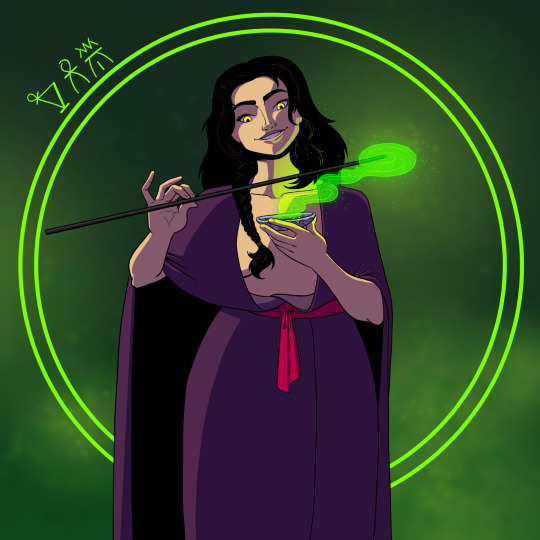
Classicstober Day 16: Circe (𐀑𐀪𐀐)
The witch-goddess of Aeaea, Circe is best known for turning sailors into animals. My take on her is partially inspired by Madeline Miller's book Circe.
I can't lie and say Madeline Miller's take on Circe was not a big part of my affection for this character, but I like to think my take on her is much more of my own.
Despite popular imaginings of her as a human witch, Circe is actually a full-blooded goddess. She is another child of Helios, the sun, and the ocean-nymph Perse (her sister Pasiphaë we have already met and her brother Aeëtes was the possessor of the Golden Fleece that Jason was looking for (and also Medea's father)). While she is full-blooded, I decided to make her look a lot more human than her sister. It makes it easier to imagine her and Odysseus together, as well as how their son Telegonus might have looked too. Like all children of Helios, Circe gets his shining yellow eyes, which help to keep her from looking too human. I think her hair is more like her mother's.
For clothing, I again borrow from Helios' palette by giving her purple. Coincidentally, for a modern audience this also mixes well with her witchy, magical role in her stories. Her clothes themselves were something I struggled with; living on an island I doubt she would be up to date on the latest Mycenaean/Minoan fashions, but I definitely wanted to evoke those shapes for her. I also wanted to stay away from the classical draped look of the chiton. Instead she wound up in this 'sheet-tied-in-the-front' kind of shawl thing.
Her wand borrows from much later art depictions of her (John William Waterhouse in particular comes to mind). For various reasons I dislike Hairy-Podder, and their short wands always kind of irked me. A wand in ancient sources is usually depicted as much larger than something a modern magician might use, so I went with that for this depiction of Circe. Her magic also derives heavily from the use of herbs, and you can see some of them in the bowl she is coaxing her spell from.
Anyhoo, happy birthday to meeeeeeeahahahaha
89 notes
·
View notes
Text


Classicstober Day 14: Helen (𐀁𐀩𐀛/𒄭𒇷𒉌)
Helen of Troy… Helen Queen of Sparta… Helen Princess of Sparta… Helen the daughter of Leda and Zeus… the face that launched a thousand ships wore many masks over the course of her life but one thing that remains the same is how compelling she remains as a character. Many thanks to @symeona for helping me with her look!
Helen is a character intrinsically associated with her appearance, but early sources do not describe her at all outside of demonstrations of her status. For this piece, I have borrowed from two sources. The first is symeona, who's excellent translations on Ancient Greek color theory informed my take on Achilles. The second was that wretched and accursed fnckboy Ovid, who described Helen's mother Leda as having 'snowy white' skin and black hair. Since Zeus appeared to Leda in the form of a swan, and considering how pale Leda was, I decided to make her somewhat swan-like in appearance, with big black eyes and naturally ruddy lips to seal the deal.
First, let's talk about Helen the Spartan (rendered here in Linear B as 'Eleni of Laconia'). Despite mainly being known for her role in the Trojan War, Helen lived the majority of her life in Sparta and her husband Menelaus claimed the throne of Sparta through her. Laconia and Sparta are some of the oldest sites of Mycenaean culture, so Helen got to be depicted as Mycenaean as all getout. The high-piled hair, the diadem, the open tunic, and the bracelet are all very common in depictions of Mycenaean and Minoan women. She also has very elaborate florets to mark her status. The red fabric and large gemstones mark her wealth too i completely forgot to draw in the necklace she wore in the sketch version.
I mentioned before in my picture of Cassandra and Hector that I am basing the Trojan looks heavily on ancient Hittite clothing, and this is no exception. I know the movie Troy sucks for lots of reasons, but I did like that they made the Trojan theme color this very rich blue so I decided to add that here; dark, rich colors in general are very expensive to produce, so even if it's not red the saturation makes the cloth very expensive and a mark of royalty. I based her clothing and jewelry off a Hittite statue, but I decided to omit the tall hats that Hittite women appear to wear under their veils; I kind of wanted that to represent status, so only Andromache and Hecuba would wear the tall hats if I depict them.
I was not trying to make a commentary with it, but it does strike me how conservative the veiled, tunic wearing Hittite woman looks compared to the open-bodiced Mycenaean woman. That could easily be read into, but I'm just going to leave it as depiction and not try to ascribe any symbolism to it.
The decorative circle around Helen represents several things. Horses feature prominently in her life. The Trojan Horse is the most well known, but the wedding oath that Tyndareus made Helen's suitors swear to was sealed with the sacrifice of a horse too. Anemones are a sacred flower to Aphrodite (long story) and the white lilies seem like a fun way to evoke the 'pure woman' image.
Also in the circle are depictions of Eris' golden Apple of Discord. For the life of me, I could not find any translation related to fairness or beauty in any Mycenaean dictionaries so I had to cheat: "𐀴 𐀏𐀪𐀯𐀳𐀂/ti ka-ri-se-te-i" is just a phonetic transliteration of ΤΗΙ ΚΑΛΛΙΣΤΗΙ (tē(i) kallistē(i)), translated as 'for the fairest.'
158 notes
·
View notes
Text

Classicstober Day 13: Arachne (𐀀𐀨𐀏𐀕)
Arachne was a mortal woman and a weaver beyond compare. She claimed that her skill surpassed even the gods'. An old woman warned her in a cracked voice:
"Be careful what you say, child; the gods loathe hybris."
"I'm not afraid of the gods. Even if Athena, goddess of weaving herself, appeared before me I know I can make a better tapestry than her!"
Arachne clearly had no idea she was living in Bronze Age Greece, because when an elder warns you about the ways of the divine it is ALWAYS a god in disguise.
Long story short, she is the reason spiders can weave so well.
Those of you who know me, and those of you who take the time to read these 'behind the scenes' things know that I do lots of research, but sometimes there just are no resources for me to draw on. Case in point, we know that the Mycenaeans had looms like the one I depict here, but as far as I know no Mycenaean tapestry has been preserved. This is not unexpected, since perishables like cloth can't really survive 3000 years without lots of luck and/or intentional preservation, but it also left me with a question of how Arachne's tapestries might have looked.
While we have some preserved Mycenaean and Minoan frescoes, I decided to not really draw from those for Arachne's tapestry. Her art was supposed to be breathtakingly realistic, so I opted from a more naturalistic, if a mite stylized, rendering of a woman. Perhaps a little anachronistic, but Arachne was a prodigy.
Speaking of which, Arachne is wearing a typical Mycenaean skirt and tunic but this piece finally gave me a good chance to show off Mycenaean makeup. Women, when depicted in Minoan and Mycenaean art, are often very pale and sometimes their faces are decorated with red florets on the forehead and cheeks. Arachne is not royal, but she is incredibly proud. Therefore I decided she would powder her face and rouge her lips, almost making herself look royal. The florets are just dots on her face, but the extras added to her forehead let me evoke the spider eyes she will bear in the near future.
Gods often take the appearance of the elderly (Zeus, Hera, and Athena all come to mind taking this disguise), and for whatever reason I have always had a vivid image of what Athena's mortal guise would look like. I know black was usually a very difficult color to dye, making it reserved for the wealthy, but maybe because of the old women in Portugal I grew up seeing the archetypal Old Woman is wearing black and using a shawl.
I would also like to formally apologize for not including the Linear B name for Athena, which is preserved: 𐀀𐀲𐀙
212 notes
·
View notes
Text

Classicstober Day 12: Theseus (𐀳𐀯𐀄)
I can't deny that I am kind of personally jaundiced against Theseus (because he sucks) but jumping into a maze with a people-eating monster to save 13 complete strangers is actually a pretty stand up thing to do.
Someone on insta asked me if I had any thoughts on the Minotaur design of Asterion, since I had depicted him as a baby on his mother's lap on that day, and I replied that he would probably look wretched.
Thinking about it more, I decided to go fully wretched for Asterion's appearance. After Minos traps him in the Labyrinth, Asterion gets very little company, if any, so he eventually loses his concept of hygiene and having any care for his appearance. There is probably precious little water in the maze, so any dirt that sticks to his hair remains in place. Dried gore from past victims remain, staining his hands and face. His nails grow long, thick, yellow, and cracked where they have torn through flesh. I imagine that Minos would fear that Asterion might make friends with any prisoner tossed into the Labyrinth, so he makes sure his beast is ravenously hungry; too hungry to think before his quarry is introduced.
Despite being massive and powerful, Asterion's constant near-starvation keeps him from growing into the bulky, massive bull-man we have come to expect. He also is not invulnerable; his body is scarred from where his victims managed to get a shot in. Scratches from nails and even some rocks prized up from the floor are visible, and one particularly vicious tribute managed to bite off part of Asterion's ear before they died.
All this combines to make a Minotaur that I actually find scary. Most of the Bulky Bull Man images are intimidating but not frightening. I feel like this version of the Bull of Minos looks like something out of a horror movie.
All in all, Asterion is a tragic figure. Born between worlds, a shame to his family, a punishment from the gods made into living flesh, and made into a monster to serve Minos' terrible will.
Theseus, on the other hand, kind of sucks as a person and this is a hill I will die on, but by this point in the story he has just done something very selfless and heroic: trade his own life for that of a complete stranger in a wild attempt to defeat the evil that threatens them. I modeled Theseus' build after power-lifters; his test of character that began his hero's journey was lifting a massive rock, after all. Theseus also has two fathers; the mortal Aegius and the god Poseidon (it's a long story). To reflect this I drew him with heterochromia. The dark eye is from Aegius, the light eye is from Poseidon.
The thread Theseus is holding is the end of Ariadne's Clew. While as far as I could find it had no inherent magical properties (although I would not put it past Daedalus to have made some of his crafts with magic) I decided to make it glow so I could have a secondary light source to really push the scariness of the scene. I think it turned out very well.
81 notes
·
View notes
Text

Classicstober Day 11: Pandora (𐀞𐀙𐀈𐀨)
Hesiod describes Pandora as the first woman, and each god gave her a gift, hence the name 'Pandora' which can be translated as 'all gifted.' Contrary to the modern popular image, Pandora was not a hapless dupe overcome by curiosity. She was made by Zeus as the original femme-fatale to inflict suffering on mankind (and also because Hesiod and ancient Greece in general were sexist as hell).
Pandora might be one of my more fanciful reconstructions; my version of her lived 400,000 years ago, long before any material culture might have been preserved, so I have nothing to go on but vibes. A friend and I decided several months ago that Pandora opening her 'box' was the cause of the "Human Bottleneck" Theory that is often linked to the eruption of Mt Toba. The Anthropology around this theory is speculative at best, but for the purposes of story I have decided to use that here too.
Since each of the gods contributed to her creation, I decided to represent them on her in various ways.
According to Hesiod, Hephaestus was the one who made the beautiful body for Pandora, which is why you can see a decorative version of his symbol painted onto her shoulder.
Aphrodite gave her … a thing that can't be said without offending the algorithm, so her symbol can be seen on Pandora's head and hands.
Hermes gave her a cunning mind, represented by the wings on her forehead, and persuasive speech, represented by his sing on her lips.
Athena clothed her in silvery robes, an embroidered veil, and an intricate crown, but since all of these things would not have been invented in the time of MY Pandora she wears a white fur, decorated with an ivory owl pin, and a crown of white cowrie shells instead.
The Graces gave her jewelry and garlands of flowers, the latter of which is the only Classical Greek element I gave to Pandora, based on depictions of garlands from classical bas relief sculpture.
Last but not least, the final gift to Pandora was from Zeus: a 'storage device' containing suffering and ailments. I have no idea when it was translated into a 'box,' but while I understand why it still does not represent the ancient myth. The classical authors described her storage vessel as a pithos, a jar used for storage. Since my version predates both concepts, I gave her an ostrich egg instead. Various anthropologists speculate that ostrich eggs might have been the first vessel humans used to carry water, and in addition to having the right shape to match a pithos an egg opens up a further metaphor: once cracked an egg can never be sealed again.
87 notes
·
View notes
Text

Classicstober Day 11: Pandora (𐀞𐀙𐀈𐀨)
Hesiod describes Pandora as the first woman, and each god gave her a gift, hence the name 'Pandora' which can be translated as 'all gifted.' Contrary to the modern popular image, Pandora was not a hapless dupe overcome by curiosity. She was made by Zeus as the original femme-fatale to inflict suffering on mankind (and also because Hesiod and ancient Greece in general were sexist as hell).
Pandora might be one of my more fanciful reconstructions; my version of her lived 400,000 years ago, long before any material culture might have been preserved, so I have nothing to go on but vibes. A friend and I decided several months ago that Pandora opening her 'box' was the cause of the "Human Bottleneck" Theory that is often linked to the eruption of Mt Toba. The Anthropology around this theory is speculative at best, but for the purposes of story I have decided to use that here too.
Since each of the gods contributed to her creation, I decided to represent them on her in various ways.
According to Hesiod, Hephaestus was the one who made the beautiful body for Pandora, which is why you can see a decorative version of his symbol painted onto her shoulder.
Aphrodite gave her … a thing that can't be said without offending the algorithm, so her symbol can be seen on Pandora's head and hands.
Hermes gave her a cunning mind, represented by the wings on her forehead, and persuasive speech, represented by his sing on her lips.
Athena clothed her in silvery robes, an embroidered veil, and an intricate crown, but since all of these things would not have been invented in the time of MY Pandora she wears a white fur, decorated with an ivory owl pin, and a crown of white cowrie shells instead.
The Graces gave her jewelry and garlands of flowers, the latter of which is the only Classical Greek element I gave to Pandora, based on depictions of garlands from classical bas relief sculpture.
Last but not least, the final gift to Pandora was from Zeus: a 'storage device' containing suffering and ailments. I have no idea when it was translated into a 'box,' but while I understand why it still does not represent the ancient myth. The classical authors described her storage vessel as a pithos, a jar used for storage. Since my version predates both concepts, I gave her an ostrich egg instead. Various anthropologists speculate that ostrich eggs might have been the first vessel humans used to carry water, and in addition to having the right shape to match a pithos an egg opens up a further metaphor: once cracked an egg can never be sealed again.
87 notes
·
View notes
Text
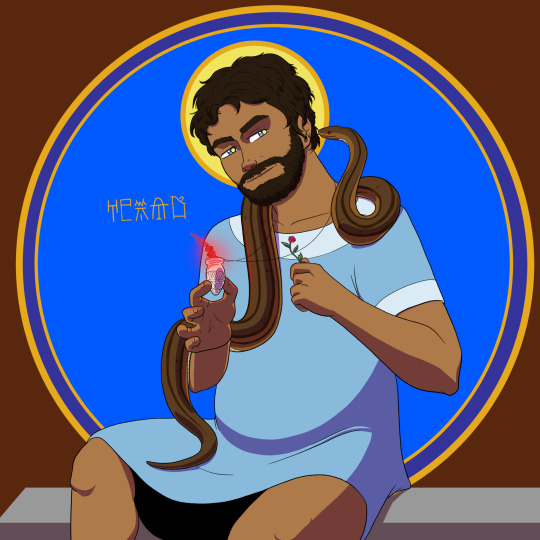
Classicstober Day 10: Asclepius (𐀀𐀱𐀐𐀠𐀃)
Asklepius, a mortal son of Apollo who received the secret of immortality and reversing death by listening to a snake. After his death he was made the God of medicine and healing per Apollo's request.
I like Asclepius. It's fun getting to use snakes as non-nefarious imagery. For funsies, I based the snake whispering in his ear off the modern snake species that uses his name. His clothes are kind of plain, but they are historically accurate for a mycenaean tunic.
I know I say that I'm trying to stay away from depictions of the divine, but Asclepius was one of the humans who became a god. For that reason I feel fine representing him. Still, to give him that little bit of divine push, he has glowing pupils and he gets a halo.
53 notes
·
View notes
Text
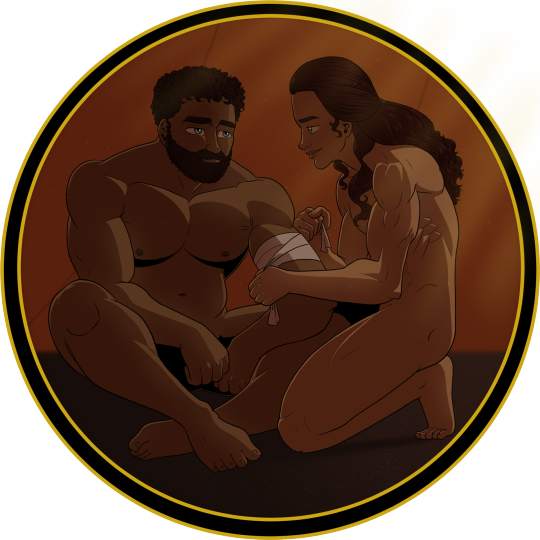
Classicstober Day 9: Achilles
Achilles and his heel are one of those myths that everyone knows, but now thanks to Madelline Miller's The Song of Achilles and SuperGiant's Hades lots more people are up to speed on the Original Tragic Gays, so why wouldn't I pay tribute to that One Vase Painting that everyone knows about while also using my own designs for these two to celebrate Achilles' day?
Patroclus and Achilles actually get some descriptive terms applied to them. Patroclus is described as bearded, dark haired, and gray-eyed, so I leaned all in on that, maybe a little self-indulgently, to make him a very handsome man.
Achilles is described as green-eyed, but one particular word that is used describe him is xanthe, which is used to describe his hair. In modern Greek it translates to blond, so many artists have rendered Achilles with a mop of shining blond curls. No shade on them, but as far as my research shows the classical Greeks would have called that color 'white,' not xanthe.
I had actually read a very interesting article about ancient Greek color descriptors (thank you @symeona for sharing it and for her own incredible insights on the translation) so with those in mind I decided to render Achilles with ruddy, chestnut hair rather than very light colors. Achilles also gets a more lean build and a prettier face than Patroclus because he was able to pass as a girl before the Trojan war.
Still, both of them were warriors so I wanted them to be Absolute Units, just different flavors of unit.
I can be a little self-indulgent sometimes, OK!?
119 notes
·
View notes
Text

Classicstober Day 8: Icarus
Icarus, the son of Daedalus, a boy who flew too close to the sun on his wax wings.
Icarus is one of those myths that everyone knows, even if they don't know it, but in artistic terms I found it a little frustrating. There are many depictions of Icarus flying, and many more depictions of him dead, but all of them make it pretty. Icarus is depicted as an adult, his body powerful and unblemished by his fall, and his wings remain magnificent. It was all too pretty, especially considering this depicts the death of a child. I decided to remedy that.
For starters, I decided to borrow from one version I read where Helios himself sends a particularly intense sunbeam to melt the wax. Wax needs high heat to melt, so Icarus is burned where he was struck. Only one wing was hit, but the impact with the ocean and the strain of the imbalance broke Icarus' arm.
The horror of all of this is magnified by both the perfectly calm ocean he landed in, empty and uncaring, and the fact that he is a child. He was so very young.
Anyway, I'm sad.
128 notes
·
View notes
Text

Classicstober Day 6: Medea
The OG (original girlboss). Her father was Aeëtes, the son of Helios and King of Colchis. Her story is a fascinating tale that evolves from a romance to a tragedy, and it makes her one of the most compelling characters in Greek mythology. She fell in love with Jason, and it was through her that he survived the quest to find the Golden Fleece. After this, they were married and lived together in Thebes until Jason decided to be The Worst and her life became a tragedy. No spoilers, but please look her up if you get the time.
How does one begin to describe Regina George Medea? Firstly, I decided to make Medea blonde. I figured that if Pasiphaë, her aunt, had physically glowing hair then Medea might have inherited some of the lightness from that side of the family, though in her case the color is much more natural. I also think it makes it more easy for her to be villain coded for her later actions. Her paleness also reflects that Colchis was both far from the standard world of the Bronze Age Mediterranean and farther north.
I tend to do LOTS of research for my art, especially when depicting ancient historical cultures, and I was mildly surprised to find that Bronze Age Colchis was a rich and thriving culture (although an illiterate one, so my use of Linear B here is just for funsies). Archaeologists have found TONS material remains from their crafts (their work with metal is particularly well preserved, so Medea gets to wear some very accurate jewelry) it was a NIGHTMARE to find any references for Bronze Age Colchian clothing. When I did find it, a single source, I was amazed by how modern it looked and I decided to use it anyway even though it does look a lot like a modern sun-dress. That's the Tiffany Effect for you.
For the colors I decided to go with red, the ancient color of royalty so of course the proud Aeëtes would dress his daughter in it, and purple. Even more than red, purple was THE color of ancient royalty, but for whatever reason I found that purple was specifically used to describe the clothing of Helios. Considering Helios lets Medea borrow his chariot in her Grand Finale Escape, I assume they were pretty close so she gets to wear his color too.
230 notes
·
View notes
